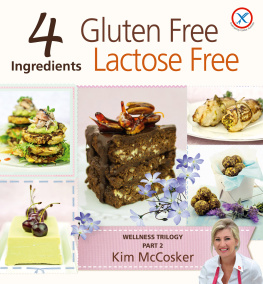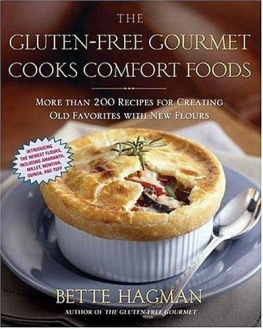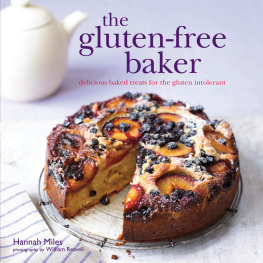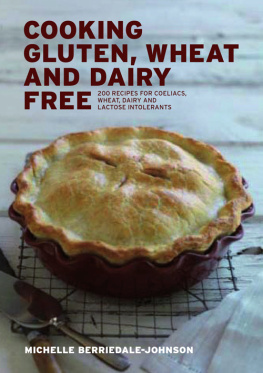THE INTOLERANT GOURMET:
GLORIOUS FOOD WITHOUT GLUTEN & LACTOSE
BY BARBARA KAFKA

ALSO BY BARBARA KAFKA
Vegetable Love
Soup: A Way of Life
Roasting: A Simple Art
Party Food
The Opinionated Palate
Microwave Gourmet Healthstyle Cookbook
Microwave Gourmet
Food for Friends
American Food and California Wine
Copyright 2011 by Barbara Kafka
Photographs copyright 2011 by Johnny Miller
All rights reserved. No portion of this book may be reproducedmechanically, electronically, or by any other means, including photocopyingwithout written permission of the publisher.
Published by Artisan
A division of Workman Publishing
Company, Inc.
225 Varick Street
New York, NY 10014-4381
www.artisanbooks.com
Published simultaneously in Canada by
Thomas Allen & Son, Limited
eISBN 9781579654931
Food styling by Christine Albano
Prop styling by Michelle Wong
CONTENTS
BEFORE WE BEGIN
I and many others are Intolerant Gourmets, lovers of good food who are celiac, unable to digest gluten (wheat, oats, and barley), which is to be gluten intolerant. I also, like many, cannot tolerate the lactose of milk in any form. These are both genetic autoimmune diseases that are not always active in the person who has them. They are often activatedparticularly in infants and small childrenby eating the taboo foods. However, it has been discovered in recent years that the genes that cause these intolerances can be activated for no known reason, even quite late in life.
Many of us are intolerant of bad food, ersatz food, and poor cooking. Despite my problems and my character, I have found that I can cook excellent food and, on my way to this happy present, I have learned a great deal about the art, theory, and practice of using unfamiliar ingredients and making things that are delicious.
In childhood, I was conspicuous, being an outsider at birthday parties, unable to eat ice cream and cupcakes due to the inevitable gluten and lactose. I had these troubles, which my children later inherited. The symptoms of these intolerances seemed to go away as I got olderexcept for an unpleasant tendency to foul the air with gas.
Perhaps my passion for food was brought on by my early deprivation; but my literary ambitions and delight in making good things to please people grew into a way of life and finally a career. Cooking for one is not my pleasureI dont normally cook for myselfbut I adore making food for friends and gradually became a food writer and at one point even had a flourishing business as a consultant to restaurants, food stores, and food manufacturers. I wrote many books. Some of them were great, thick tomes. I wrote for magazines, newspapers, and almost everyone who asked. I spouted words on radio and television. It was hard work, but fun.
Then, as I got older, the old symptoms returned and I had to change what I cooked and avoid writing about many dishes, as I couldnt taste all things and I will not give a recipe for anything I cannot stand behind. I thought that I had reached an age at which to stop writing. However, good friends convinced me that what I was learning should be made into yet one more book, that it was a gift worth giving. Besides, I missed the act of writing and having contact with readers, cooks, and eaters. I didnt miss cooking and eating because they were constants in my life.
Writing this book is not just about me. For some reason that no one seems to understand, the number of the gluten intolerant has increased ten times in recent years. It has always been true that 60 percent of the population cannot fully digest dairy (lactose). Although they are unrelated genetically, lactose intolerance and gluten intolerance often occur in the same person. These intolerances are not allergies, but genetic disorders that make life difficult and unpleasant. They can vary in evidencing their presence or intensity over time; but they do not disappear. I must limit what I make and eat. No one for whom I cook seems to complain and I hope that by sharing what I do, I can make some lives a great deal more pleasant without a great deal of work.
NOT A PLAGUE: A BLESSING
Those of us who are Intolerant Gourmetseither of gluten, lactose, or bothtend to think that we have a disease and perhaps even a curse. In truth, while it is a disease and difficult to live with, it may be a blessing in disguise. Certainly it has been shown that simple, rapidly digested carbohydrates, of which wheat flour is one, disrupt the normal digestion in ways other than the evident. Their rapid absorption into the system does funny things to insulin production and can lead the way to diabetes as well as other unpleasant things. All nutrition is more complicated than this; but it may give some comfort.
SENSATIONS PLUS TASTES
Food is not just about flavor. It is also about sensation. I think that the lavish usual usage of butter and cream provides silkiness while carrying flavors. Butter and cream are hard to replace; but as I have tested recipes and written this book, I am constantly endeavoring to find equivalent replacements for the pleasure. The natural gelatin from good stock or added commercial gelatin, egg yolks, coconut milk, and various oils from olive to toasted sesame all help in part. I have also found that certain nuts and legumes pured help as well. I hope that soon the craving for lactose will leave you and the desire for silky sensation will be satisfied.
ALMOST EVERYTHING YOU WANT TO EAT
This is a book that will satisfy your need for mashed potatoes and other buttery dishes and pastasbut not with substitutes and eccentricities. It is meant to serve as an all-purpose cookbook for us intolerants and our intolerant friends and family. In many cases this has meant rethinking or reformulating classic recipes without the use of flour or butter as a thickener, or the use of butter as a base for cooking and cream to round out a sauce. There are, of course, really new recipes; I can never resist the lure of the kitchen.
I hope that I have written a book that will make it possible for all of us to enjoy these foods without recourse to ersatz ingredients or expensive bought items often using a wide range of chemicals.
One of the few things that I serve that I dont make is pasta. There are companies that seem to have conquered the art of making pasta without using wheat flour. I have found only one brand of gluten-free bread that has been reasonable; the rest have invariably proved disappointing, and even the good one is best when toasted, since its fragile.
SANDWICH GOOD-BYE
I think the hardest thing about going on a gluten-free diet was being deprived of sandwiches. Ive never been much of a breakfast eater so it was only rarely that I coveted someones crisp toast slathered in butter (whoops, lactose). What I missed most were very American things: a street-cart frankfurter, a tuna sandwich on toast with mayo, lettuce, and tomato, or a BLTlet alone a pastrami on rye. I mourned my favorite, the fully summer-ripe tomato, dripping into the kitchen-sink sandwich with mayo out of a jar on commercial, squooshy white bread.
I still havent recovered. Yes, Ive tried the valiant attempts at gluten-free breadimagine my dismay when one of my favorite restaurants in Venice offered me gluten-free bread and after eating it (actually gorging on it), I became ill. A little reflection and a little research detected the ample presence of butter and milk. I have even come up with my own gluten-free white bread (delicious but too fragile for sandwiches, it makes great toastsee ); but this hasnt been the comfort that many of the gluten-free commercial pastas have. I did discover that I could make a reasonable imitation of a sandwich using corn tortillas heated up for about thirty seconds in the microwave.









